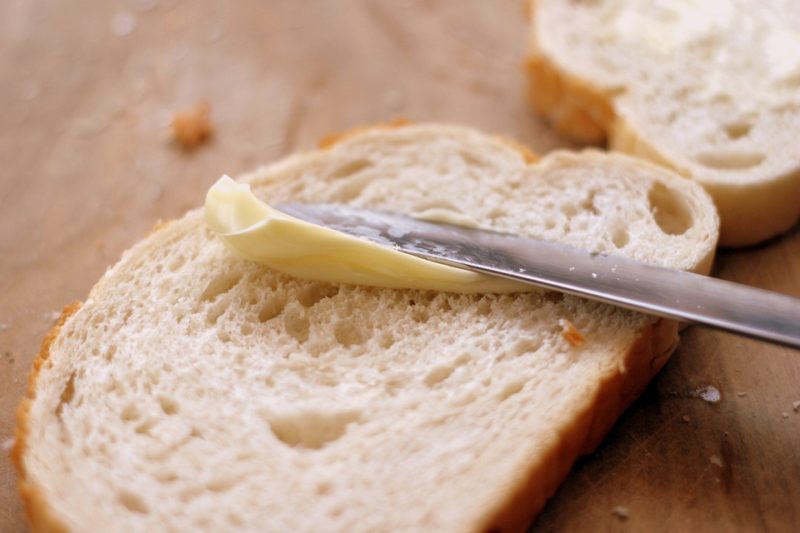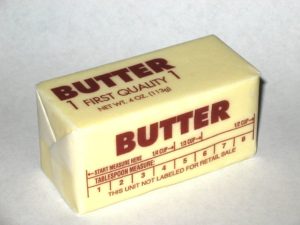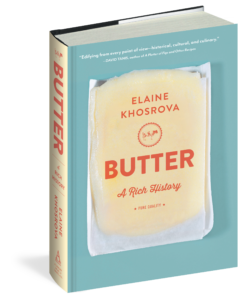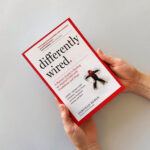Butter has a rocky reputation. From moment to moment, the ubiquitous ingredient is heralded as a natural, delicious ingredient rich in Vitamin A, and decried as an evil, artery-clogging source of saturated fat and cholesterol. Some of us were raised on margarine and Smart Balance by parents who shunned butter as a recipe for early onset heart disease. Others were fed the dairy product in its purest form, believing all substitutes to be tasteless, chemical-ridden imposters. Which is it? Elaine Khosrova, celebrated author of Butter: A Rich History explains.

Could you start off by telling us a bit about what butter is, and how long humans have been eating it?
Legally, by FDA standards, butter is defined as the food product “made exclusively from milk or cream, or both, with or without common salt, and with or without additional coloring matter, and containing not less than 80 per cent by weight of milk fat.” Put more simply, butter is a solid concentration of the fat in milk. It’s made by agitating (a.k.a. churning) cream or non-homogenized whole milk, which causes the tiny membrane cloaking each floating fat molecule to break. Once these membranes break, the liquid and crystalline fats inside leak out and coalesce with fats from other molecules. When the fats cluster, we get pieces of butter, bobbing in the leftover opaque liquid known as buttermilk. (Traditional buttermilk, FYI, is tangy and acidic because the cream or milk has been cultured before churning.) The buttermilk is drained off and the butter is worked into a cohesive mass.
Humans have been eating butter for a very long time—since the earliest domestication of animals. We know that dairying existed around 9000 B.C.E. in the region of what is now Iran, so we assume that early people eventually began preserving the milk through butter and cheesemaking. But the earliest written record of buttermaking is from Sumerian temple carvings, which date to 2500 B.C.E.
Let’s talk margarine, Smart Balance, and all of those other substitutes out there. What are they made of, and how do you feel they compare to the real thing?
All butter substitutes are made from various vegetable oils that are highly processed to strip them of any natural color or flavor (so they can become butter-flavored and -colored), and to make them solid at room temperature, like butter. Partial hydrogenation—the fusing of hydrogen molecules onto fatty acids—was the most common way of turning a liquid oil to a solid fat for more than sixty years. But in 2013, the FDA finally accepted the (decades-old) science that proved hydrogenation creates freak fats, known as man-made trans fats, which greatly increase the risk of heart disease and other degenerative conditions. As alarm about trans fat from hydrogenated oils ensued, food chemists switched to the process of interesterification to solidify vegetable oils for margarine making. In this technology, the aim is to rearrange triglyceride molecules by blending vegetable oil and water with a tiny portion of fully hydrogenated oil (which is very hard) using heat and a chemical catalyst, such as sodium methoxide or ethoxide (industrial solvents). The end product is then neutralized (to remove the catalyst), bleached (to eliminate the resultant brown color) and deodorized. Finally, artificial and natural flavoring and coloring are added; in the case of Smart Balance, calcium disodium is also added as a preservative.
I haven’t done a taste survey of these spreads because their processing makes them inherently unappealing and suspect to me. So I can’t comment on their flavor versus butter. I imagine they have great spreadability. But so does the butter I keep in my room-temperature ceramic butter keeper.
 What are the health benefits, and risks, of consuming real butter vs. margarine?
What are the health benefits, and risks, of consuming real butter vs. margarine?
In the case of margarine, most of us erroneously assume that because it’s “vegetable” in origin it’s healthier than an animal product, like butter. But that certainly wasn’t the case with the trans fat–containing margarines Americans were eating from the 1950s up until 2013; turns out they promote heart disease, as well as cancer and obesity. And even now, with the new generation of interesterified margarines, there are some early warning signs: health reports suggest these synthetic fats inhibit insulin output by the pancreas, causing higher blood sugar levels. (Diabetics take heed.) These new spreads—and the oils they’re made with—are laboratory foods that we’re simply not designed to eat. Whereas people have been eating butter for thousands of years. It’s worth noting that while margarine consumption was steadily rising in the latter half of the twentieth century, so were heart disease rates. Meanwhile butter consumption plummeted throughout the century to an all time low.
The longstanding indictment against butter is from the fact that its saturated fat can raise “bad” cholesterol—LDLs. But the latest research shows that these LDLs are a light, fluffy version that does not embed itself in your arteries. Whereas a more dangerous kind of LDL—small, dense, and invasive—is made in the liver when we eat sugars and refined carbs. Butter’s saturated fat also raises HDLs—the so-called good cholesterol which does not cause heart disease. Vegetable oils do not boost HDLs.
One of the saturated fats in butter—margaric acid—actually works to reduce heart disease. And butter is also about one-third oleic acid, the same good-for-you monounsaturated fat found in olive oil. Grass-fed organic butter also has plenty of disease-fighting CLA (conjugated linoleic acid) and vitamin K2. But the omega-6 fats found in polyunsaturated products like margarine show no cardiovascular benefit and may actually increase the risk of heart disease by promoting inflammation. Undoubtedly grass-fed organic butter is the healthiest option, but I would also choose standard butter over margarines and vegetable oil spreads.
When we travel to Europe—France especially—some of us find that the butter there is worlds apart from what we find in America. As in, it’s so good that you could blissfully eat thick, cheese-like wedges of it on a piece of baguette and be content. What accounts for this disparity?
I think that disparity no longer exists, if you seek out better American butters. European butters used to be superior because, in the post-war decades of the 20th century, most American butter was all the same mild, sweet (uncultured) standardized butter made from the milk of grain-fed cows at industrial creameries. By contrast, many great European (especially French) butters have long been produced in smaller batches, with cultured cream, from the milk of cows on rich pasture. These factors result in a more nuanced, complex flavor. French butters are also richer—at least 82% fat, whereas standard American butters are 80% fat.
Rediscovering these traditional methods that once existed in American buttermaking, many smaller commercial creameries in the U.S. are sourcing better cream from organic and grass-fed dairies, culturing the cream before churning, and/or increasing the fat content in their butter to 82% or more. The store and farm market shelves are proof that what’s old is new again: there are evermore domestic choices that rival fine European butters.
What are your favorite brands of butter that can be easily found in the US?
There are so so many; I created a four-page listing in the back of my book of recommended butters! I list them within distinct categories of sweet, cultured, artisan, industrial (continuous churn), and higher fat brands. Regardless of these style preferences, I will always unequivocally recommend choosing a grass-fed organic butter as a staple brand. Other kinds can be interesting to sample now and then, but they’re not as nutritious or wholesome. If you eat even a little butter every day, the nutrients in grass-fed brands add up. Kerrygold, Organic Valley, and Anchor brands are widely available grass-fed butter choices, but there are also many artisan butters from small local creameries whose cows are on pasture seasonally. They are worth seeking out. Alternately, you can buy the cream from a grass-fed dairy operation and make your own butter! (Instructions in my book.)
What are some of your favorite facts and/or stories that you learned in the research and writing of your book?
One big surprise was discovering the important role butter played in early spiritual and religious practices around the world. From the Sumerians and Druids to the Buddhists and Hindus, butter was a tool in many of their pagan and sacred rituals. Some of these rituals even continue today, such as Tibetan butter carving.
The universal gender divide in the pre-industrial dairy world was also another fascinating topic. Since it was virtually taboo for men to be involved in the female domain of milking and transforming the milk, women gained a rare measure of socioeconomic status from their dairy skills. I delved a lot into the life and work of dairymaids and how all that changed when buttermaking moved from the farm to the factory in the late 1800s.
I found lots of fun factoids about butter in my research, too. One of my favorites: The first student protest in North America happened at Harvard in 1766 in a revolt against butter that “stinketh.” Half the student body, led by Asa Dunbar (Henry David Thoreau’s grandfather), walked out on account of the very rancid butter being served to them. The students were immediately suspended. The record shows they were eventually readmitted, but not whether the butter improved.
What’s your verdict: is butter underrated or overrated?
Underrated—for far too long!
 About the Book:
About the Book:
“Edifying from every point of view–historical, cultural, and culinary.” —David Tanis, author of A Platter of Figs and Other Recipes
It’s a culinary catalyst, an agent of change, a gastronomic rock star. Ubiquitous in the world’s most fabulous cuisines, butter is boss. Here, it finally gets its due.
After traveling across three continents to stalk the modern story of butter, award-winning food writer and former pastry chef Elaine Khosrova serves up a story as rich, textured, and culturally relevant as butter itself.
From its humble agrarian origins to its present-day artisanal glory, butter has a fascinating story to tell, and Khosrova is the perfect person to tell it. With tales about the ancient butter bogs of Ireland, the pleasure dairies of France, and the sacred butter sculptures of Tibet, Khosrova details butter’s role in history, politics, economics, nutrition, and even spirituality and art. Readers will also find the essential collection of core butter recipes, including beurre manié, croissants, pâte brisée, and the only buttercream frosting anyone will ever need, as well as practical how-tos for making various types of butter at home–or shopping for the best.
Buy the Book
Amazon | B&N | Indiebound | Workman





No Comments